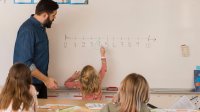Using Calculation Stations in Elementary Math
From days of school to number of teeth lost, calculation stations make math relevant and a part of daily routines.
Your content has been saved!
Go to My Saved Content.“It’s just that I’m never going to use a number line in real life! I would count on my fingers or do the math in my head,” a student protested with frustration.
She was a very capable math student, but the visual number line was bogging her down, and she was not the first to question why the class needed to learn certain math concepts. Another student often pressed me on why we needed to practice skip-counting in various intervals, claiming that she would never count by fives when she could just count by 10s faster.
Students aren’t wrong to question why we learn these skills. Their logic was sound for first graders. After all, why would you spend time learning to count by fives when you could simply count by 10s?
Considering students’ questions, I realized that I needed to show my students the relevance of math in their everyday lives, but I knew I needed to do so outside of formal math lessons and without explicitly discussing what I was trying to do. Students would need to make the connection on their own if they were going to embrace the day-to-day value of math.
My solution? The calculation station.
OUR CALCULATION STATION
The calculation station offers an access point for students to engage with math concepts, and it is applicable to all levels of learners. In my first-grade classroom, it involves a bulletin board on which we track and record math learning throughout the year.
We start with 10 frames and a three-pocket chart that holds sticks representative of how many days have passed in the school year. We also have a graph visualizing the number of teeth that students have lost and a tally recording sheet for the number of books we read. As the year proceeds, we sometimes add other elements to the board to align with students’ interests.
GETTING STARTED WITH YOUR STATION
Implementing a calculation station in your classroom can create excitement about math in everyday routines. The station itself can be as simple or intricate as you like; it can be a central part of your school day or a subtle reminder that math is present in nearly everything.
To put this idea into practice, you should first identify and create a space for the calculation station. Find a spot where you can display it centrally. I use a bulletin board, but you could post items on the board or the back of your door, or on a table or bookshelf. Wherever you choose to set up the station, be sure that students can access and refer to it easily.
Next, decide how and what you will calculate. As I mentioned, I start the year by tracking four things: days of school using sticks, days of school using 10 frames, lost teeth using a bar graph, and number of books read using tally marks. I chose these categories because the students are interested in them. They love sharing when they lose a tooth, and they enjoy having an easy way to check in on our school day count.
Connecting to Students’ Interests
The key to a successful calculation station is counting things that matter to the students; doing so encourages them to see how math plays a role in their everyday lives, at and beyond school. You will also want to vary how you count so that students can see the applicability of different math strategies—from skip counting to graphs and more.
Days of school, for example, could connect to multiple math skills: grouping, fluent skip counting, and place value practice among them. The lost tooth graph can facilitate data collection and graphing. Number of books read involves interval counting.
Other data and requisite math skills might include birthdays (graphing); name lengths (measurement); weather patterns (pattern identification); height (measurement); rewards, if you use a whole-class reward system such as a pom-pom jar (making predications and inferences, considering inquiries like “How many more?”); and, finally, sports results (making comparisons).
MAINTAINING CONSISTENCY
The calculation station does not have to be another lengthy activity to fit into your day. However, you should make a plan to reference it consistently. For example, I discuss mine during morning meeting, and one of our weekly class jobs is “analyst,” so students take turns adding to and updating our station.
Sometimes we just add a stick to our pocket chart and a dot on our 10 frame and move on with our day. Other times, we talk in detail about why tally marks or a graph would be the best counting strategy to use for certain types of data. Making sure that students get to take on an active role in updating the station supports their engagement and sense of agency.
Throughout the year, as this routine becomes integrated into your classroom community, students may come up with a new idea to add—a new type of information to track. Or, they may lose interest in a certain element of the activity, and that’s OK. You can change the calculation station to reflect student interests or revise how you’re counting when students learn new skills that would be more suitable.
Ultimately, the calculation station teaches students how to recognize the relevance of math in their everyday lives, which can lead to greater understanding, enjoyment, and success in the subject. Simultaneously, the station serves as a way to foster community by celebrating students (newly lost teeth, milestones in your days-of-school count, etc.) and by creating opportunities for participation in math outside of formal math lessons—all while offering additional support and exposure for struggling learners working to practice counting.
